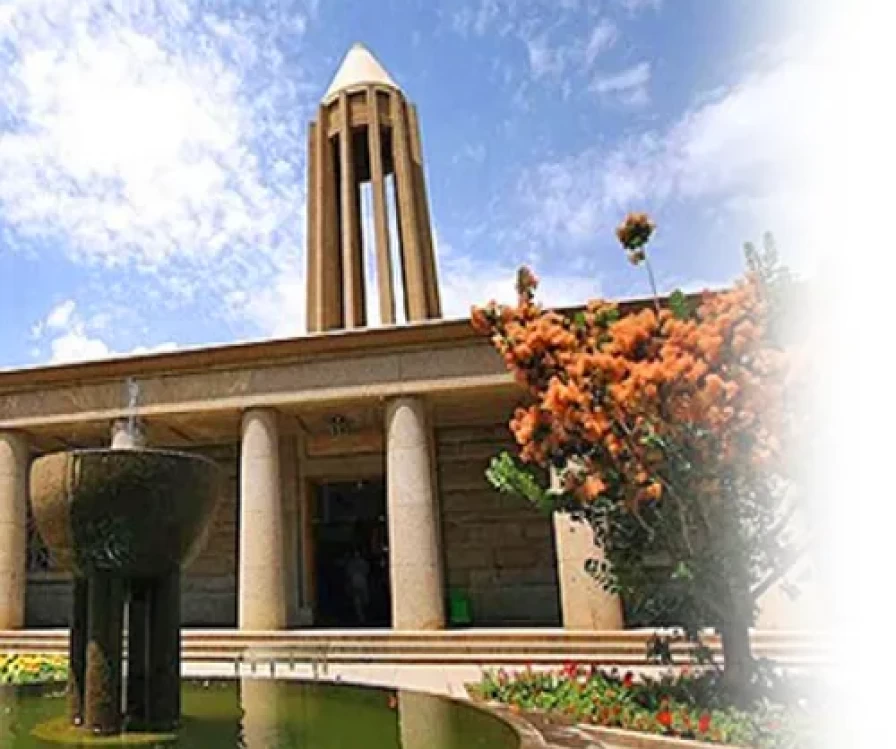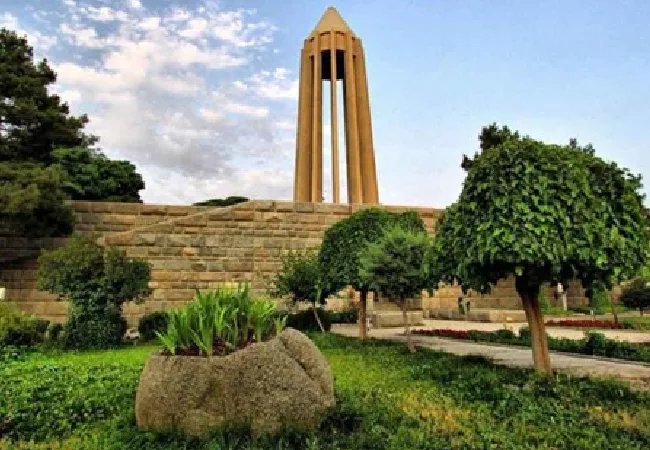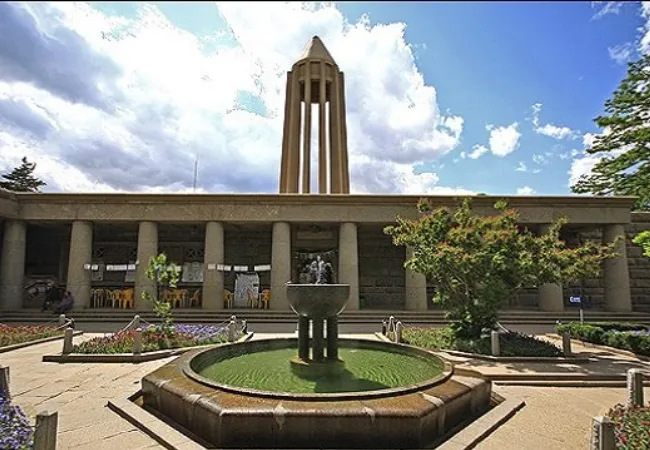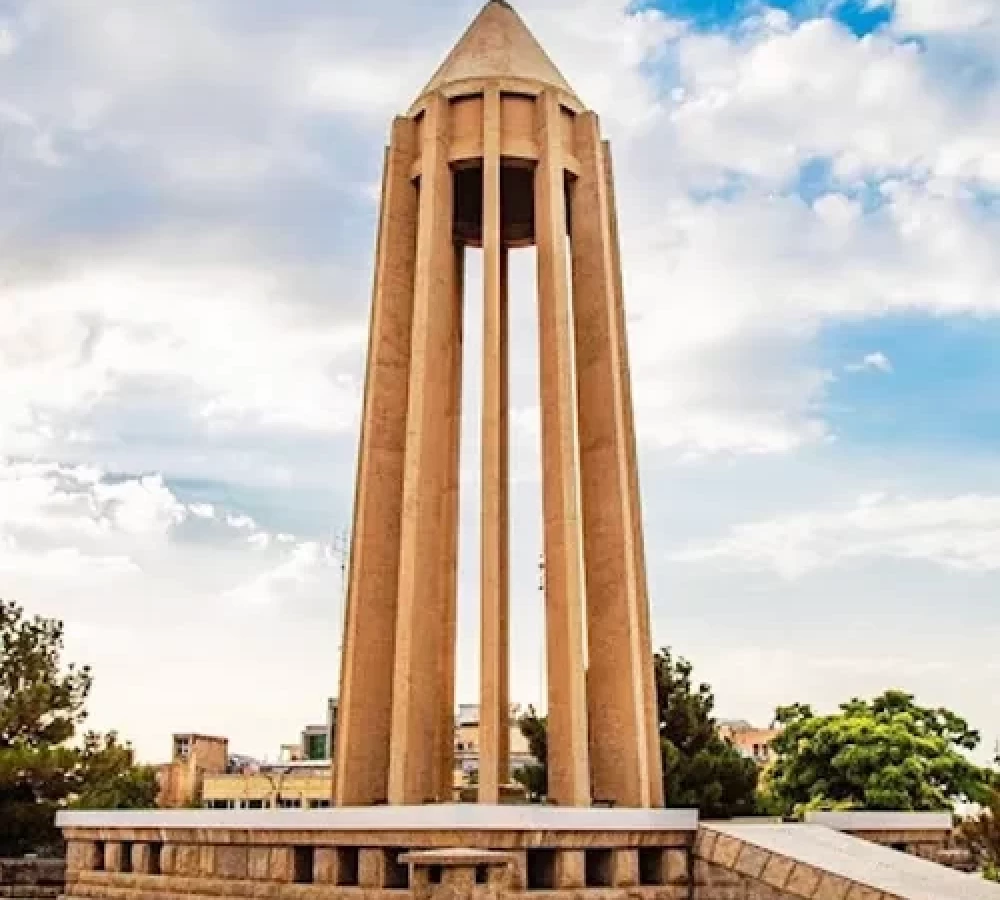
Tomb of Avicenna







Tomb of Ibn Sina
The Mausoleum of Avicenna stands in Hamadan, the city where he passed away. Today, it remains one of the city’s most prominent landmarks. Located in one of Hamadan’s main squares, the mausoleum lies between the northern and southern Bou Ali Sina Streets, bordered by Ayatollah Madani Boulevard to the east and Khwaja Rashid Boulevard to the west. It was built in 1948, based on the design of the celebrated Iranian architect Hooshang Seyhoun, whose plan had won a national competition. The tomb of the famous poet Aref Qazvini is also situated nearby.
Abu Ali Husayn ibn Abdullah ibn Hasan ibn Ali ibn Sina—known in the West as Avicenna, and in Persian as Bu Ali Sina or Sheikh al-Ra’is—was born in 980 CE (370 AH) and passed away in 1037 CE (428 AH). He was a polymath, excelling as a physician, mathematician, astronomer, physicist, chemist, geographer, geologist, logician, philosopher, poet, and statesman. Avicenna is regarded as one of the most influential thinkers and scientists of the Islamic Golden Age, and his works left a lasting mark on both Eastern and Western thought.
His most significant books include The Book of Healing (Kitab al-Shifa), a vast philosophical and scientific encyclopedia, and The Canon of Medicine (Al-Qanun fi al-Tibb), which served as a standard medical text in Europe and the Islamic world for centuries. Displaying exceptional intelligence from a young age, Avicenna became a renowned scholar and physician in the court of the Samanid ruler Amir Nuh ibn Mansur in Bukhara. After the fall of the Samanids, he traveled to Gorganj (Khwarazm), then to Gorgan, and later to Rayy, where he served Majd al-Dawla of the Buyid dynasty. Eventually, he became the vizier of Shams al-Dawla in Hamadan. Following a period of imprisonment after the ruler’s death, Avicenna escaped to Isfahan, where he entered the service of Ala al-Dawla. He remained there until his final journey to Hamadan, where he died.
Throughout his lifetime, Avicenna wrote about 450 works, many of which were devoted to philosophy and medicine. The historian George Sarton described him as one of the greatest thinkers and physicians of all time.
The Philosophy Encyclopedia of the University of Tennessee lists him among the most influential philosophers before the modern era, noting his profound impact on later figures such as Mulla Sadra, Thomas Aquinas, and Descartes. His legacy gave rise to the “Avicennian School” in both Islamic and medieval European philosophy.
In Iran, his birthday—August 23rd (1st of Shahrivar)—is celebrated as National Doctor’s Day. It is believed that Avicenna fell ill during a journey to Hamadan and died there in 1037 CE (2nd of Tir, 416 AH), likely from cancer, though the exact cause remains uncertain.
The Mausoleum of Avicenna is a memorial dedicated to this great Iranian philosopher, scientist, and physician. It
stands in Bou Ali Square, at the heart of Hamadan, and was registered as a National Heritage Site of Iran on May 11, 1997, under registration number 1869.
The earlier mausoleum was built during the Qajar era, reportedly by Negar Khanum, a granddaughter of Fath-Ali Shah Qajar. Plans for the current structure began in 1943, when Mohammad Reza Shah Pahlavi personally allocated 100,000 tomans for the project. The National Monuments Association of Iran commissioned the design through a public competition, which was won by Hooshang Seyhoun, who drew inspiration from the ancient Gonbad-e Qabus Tower—one of the oldest surviving Islamic monuments. Funding for the construction was later supplemented through the sale of stamps and public donations. In 1948, the Ministry of Culture proposed a national lottery to raise additional funds for the mausoleum’s completion and inauguration ceremony. By 1951, construction costs had reached 1.2 million tomans, a remarkable sum for the time. Several organizations, including the Red Lion and Sun Society, the Imperial Organization for Social Services, Hamadan Municipality, and the Parsees of India, contributed to the funding. The new mausoleum was completed in 1954 and officially inaugurated on April 29, 1954, in the presence of Mohammad Reza Shah Pahlavi and Queen Soraya. The site chosen for the monument was once the home of Abu Saeed Dakhouk, Avicenna’s close friend. His remains were reinterred here, and even a photograph of Avicenna’s skull—taken during the reburial—is displayed inside the museum.
The mausoleum combines elements of ancient Persian and Islamic architecture. It features a tower inspired by Gonbad-e Qabus, traditional Persian gardens and water pools, and a facade built from granite quarried from Mount Alvand, reflecting the timeless strength of Iran’s historic palaces. According to Hooshang Seyhoun, the ten columns at the entrance symbolize the ten centuries that had
passed since Avicenna’s time, while the twelve columns of the tower represent the twelve branches of knowledge in which he excelled.
Today, the southern hall houses an archaeological museum, displaying coins, pottery, and bronze artifacts from pre-Islamic and Islamic periods. The northern hall contains a library with around 8,000 rare manuscripts and printed books, as well as exhibits dedicated to Avicenna and other Hamadan poets and writers. The surrounding park forms a semicircular green space, and a statue of Avicenna holding a book stands proudly on the eastern side of the square. Interestingly, images of the mausoleum have appeared on Iranian banknotes both before and after the Islamic Revolution, and it remains one of the city’s most iconic landmarks, attracting thousands of visitors each year.
The mausoleum’s library is considered one of Iran’s important cultural treasures, frequently used by researchers and students.
The mausoleum was designed by Hooshang Seyhoun, one of Iran’s most renowned architects, painters, and sculptors. Known as “the man of enduring monuments,” he also designed the tombs of Khayyam, Nader Shah Afshar, Ferdowsi, and Kamal-ol-Molk.
Seyhoun’s architectural philosophy was rooted in logic and simplicity—he believed every line and form must have meaning and purpose. He despised meaningless ornamentation, insisting that truth in architecture, even when stark or raw, always possesses its own beauty. The Mausoleum of Avicenna holds a special place in the hearts of Iranians. Visiting it is seen not only as a cultural experience but also as a tribute to one of the greatest minds in human history. We, the Sana Persian Team, look forward to welcoming you soon to Hamadan, Iran, and to the Mausoleum of Avicenna. We hope to see you there!
Contact Us
+989054577261